Australian covert bullying prevalence study -
VerifiedAdded on 2022/09/09
|7
|1516
|15
AI Summary
Contribute Materials
Your contribution can guide someone’s learning journey. Share your
documents today.
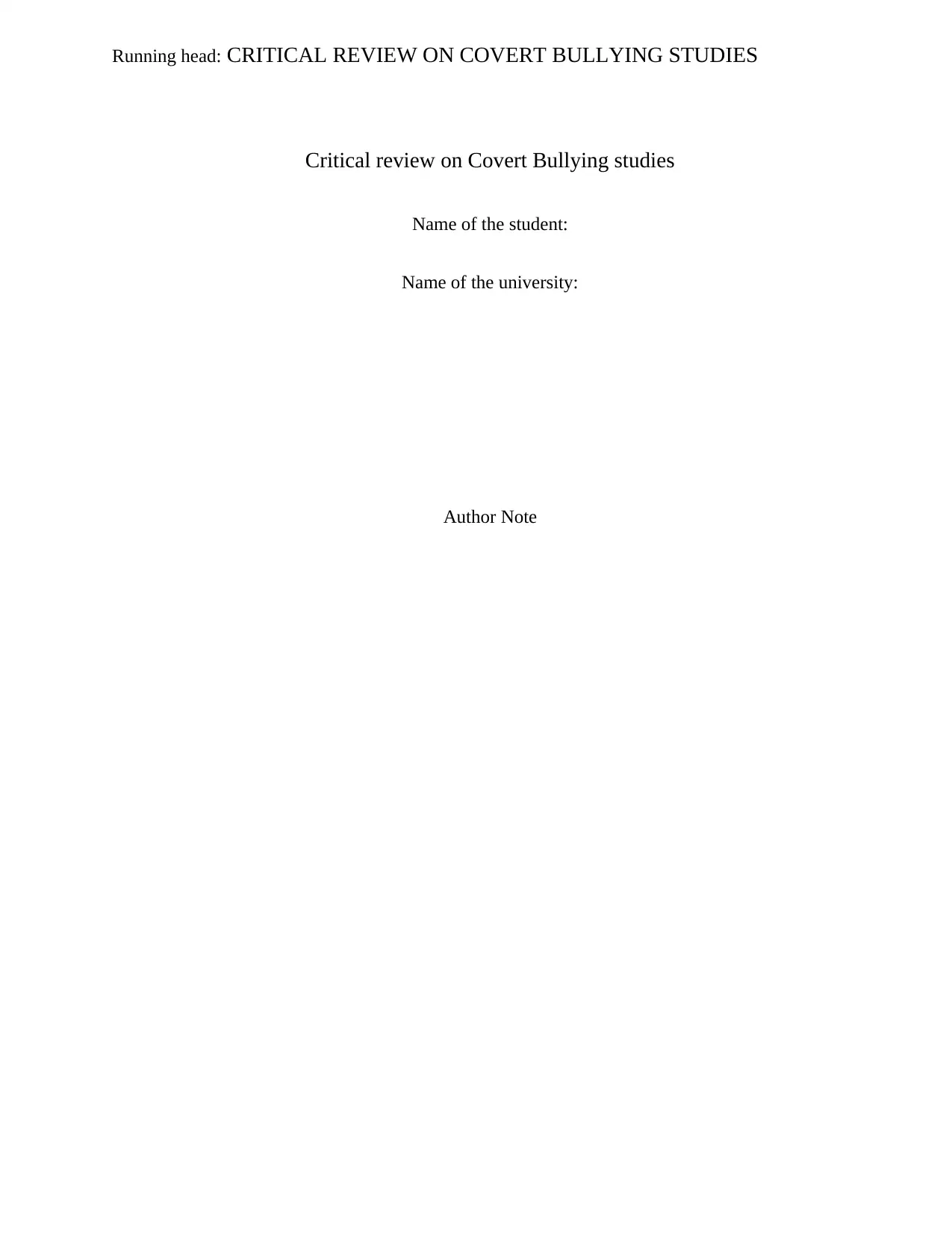
Running head: CRITICAL REVIEW ON COVERT BULLYING STUDIES
Critical review on Covert Bullying studies
Name of the student:
Name of the university:
Author Note
Critical review on Covert Bullying studies
Name of the student:
Name of the university:
Author Note
Secure Best Marks with AI Grader
Need help grading? Try our AI Grader for instant feedback on your assignments.
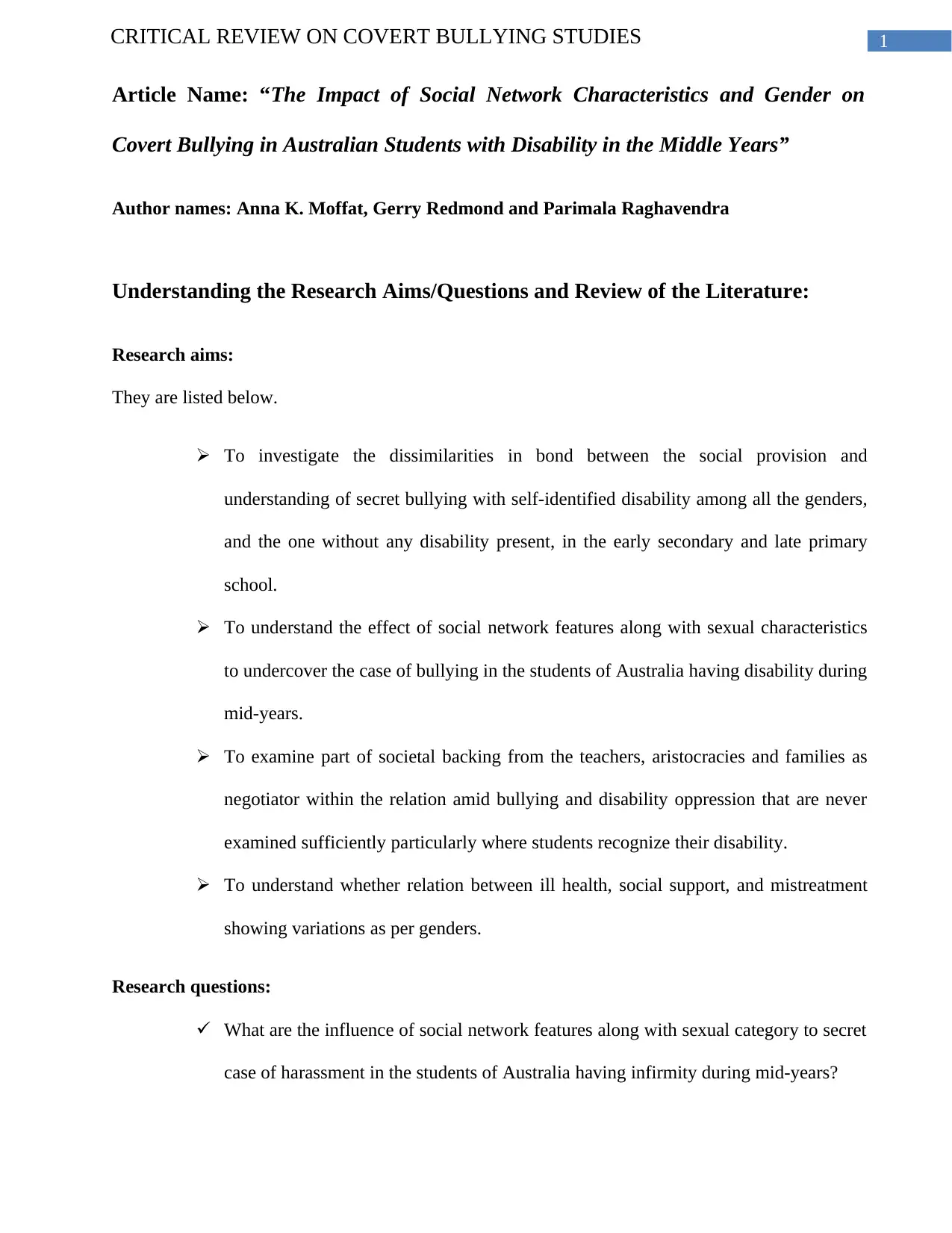
1CRITICAL REVIEW ON COVERT BULLYING STUDIES
Article Name: “The Impact of Social Network Characteristics and Gender on
Covert Bullying in Australian Students with Disability in the Middle Years”
Author names: Anna K. Moffat, Gerry Redmond and Parimala Raghavendra
Understanding the Research Aims/Questions and Review of the Literature:
Research aims:
They are listed below.
To investigate the dissimilarities in bond between the social provision and
understanding of secret bullying with self-identified disability among all the genders,
and the one without any disability present, in the early secondary and late primary
school.
To understand the effect of social network features along with sexual characteristics
to undercover the case of bullying in the students of Australia having disability during
mid-years.
To examine part of societal backing from the teachers, aristocracies and families as
negotiator within the relation amid bullying and disability oppression that are never
examined sufficiently particularly where students recognize their disability.
To understand whether relation between ill health, social support, and mistreatment
showing variations as per genders.
Research questions:
What are the influence of social network features along with sexual category to secret
case of harassment in the students of Australia having infirmity during mid-years?
Article Name: “The Impact of Social Network Characteristics and Gender on
Covert Bullying in Australian Students with Disability in the Middle Years”
Author names: Anna K. Moffat, Gerry Redmond and Parimala Raghavendra
Understanding the Research Aims/Questions and Review of the Literature:
Research aims:
They are listed below.
To investigate the dissimilarities in bond between the social provision and
understanding of secret bullying with self-identified disability among all the genders,
and the one without any disability present, in the early secondary and late primary
school.
To understand the effect of social network features along with sexual characteristics
to undercover the case of bullying in the students of Australia having disability during
mid-years.
To examine part of societal backing from the teachers, aristocracies and families as
negotiator within the relation amid bullying and disability oppression that are never
examined sufficiently particularly where students recognize their disability.
To understand whether relation between ill health, social support, and mistreatment
showing variations as per genders.
Research questions:
What are the influence of social network features along with sexual category to secret
case of harassment in the students of Australia having infirmity during mid-years?
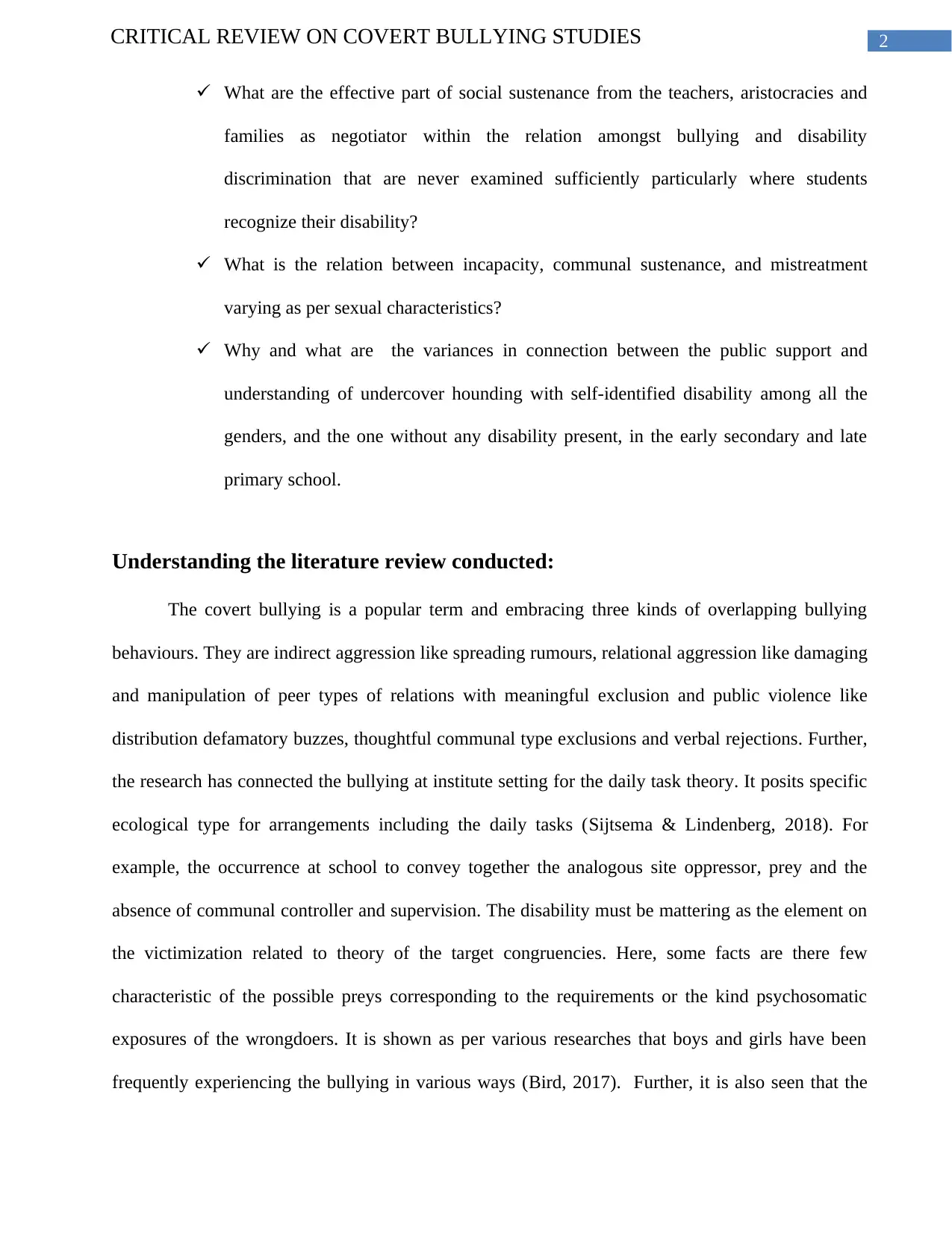
2CRITICAL REVIEW ON COVERT BULLYING STUDIES
What are the effective part of social sustenance from the teachers, aristocracies and
families as negotiator within the relation amongst bullying and disability
discrimination that are never examined sufficiently particularly where students
recognize their disability?
What is the relation between incapacity, communal sustenance, and mistreatment
varying as per sexual characteristics?
Why and what are the variances in connection between the public support and
understanding of undercover hounding with self-identified disability among all the
genders, and the one without any disability present, in the early secondary and late
primary school.
Understanding the literature review conducted:
The covert bullying is a popular term and embracing three kinds of overlapping bullying
behaviours. They are indirect aggression like spreading rumours, relational aggression like damaging
and manipulation of peer types of relations with meaningful exclusion and public violence like
distribution defamatory buzzes, thoughtful communal type exclusions and verbal rejections. Further,
the research has connected the bullying at institute setting for the daily task theory. It posits specific
ecological type for arrangements including the daily tasks (Sijtsema & Lindenberg, 2018). For
example, the occurrence at school to convey together the analogous site oppressor, prey and the
absence of communal controller and supervision. The disability must be mattering as the element on
the victimization related to theory of the target congruencies. Here, some facts are there few
characteristic of the possible preys corresponding to the requirements or the kind psychosomatic
exposures of the wrongdoers. It is shown as per various researches that boys and girls have been
frequently experiencing the bullying in various ways (Bird, 2017). Further, it is also seen that the
What are the effective part of social sustenance from the teachers, aristocracies and
families as negotiator within the relation amongst bullying and disability
discrimination that are never examined sufficiently particularly where students
recognize their disability?
What is the relation between incapacity, communal sustenance, and mistreatment
varying as per sexual characteristics?
Why and what are the variances in connection between the public support and
understanding of undercover hounding with self-identified disability among all the
genders, and the one without any disability present, in the early secondary and late
primary school.
Understanding the literature review conducted:
The covert bullying is a popular term and embracing three kinds of overlapping bullying
behaviours. They are indirect aggression like spreading rumours, relational aggression like damaging
and manipulation of peer types of relations with meaningful exclusion and public violence like
distribution defamatory buzzes, thoughtful communal type exclusions and verbal rejections. Further,
the research has connected the bullying at institute setting for the daily task theory. It posits specific
ecological type for arrangements including the daily tasks (Sijtsema & Lindenberg, 2018). For
example, the occurrence at school to convey together the analogous site oppressor, prey and the
absence of communal controller and supervision. The disability must be mattering as the element on
the victimization related to theory of the target congruencies. Here, some facts are there few
characteristic of the possible preys corresponding to the requirements or the kind psychosomatic
exposures of the wrongdoers. It is shown as per various researches that boys and girls have been
frequently experiencing the bullying in various ways (Bird, 2017). Further, it is also seen that the
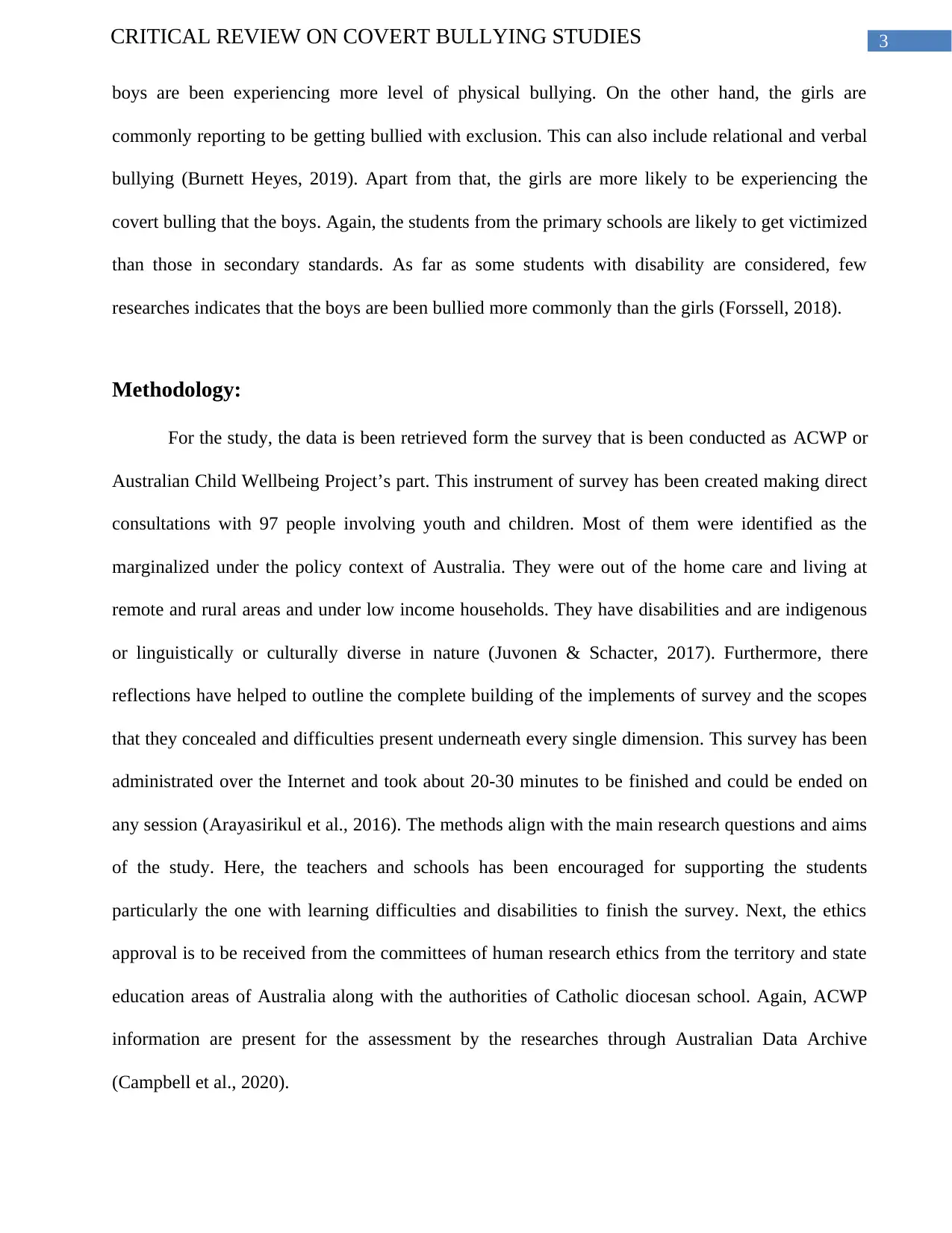
3CRITICAL REVIEW ON COVERT BULLYING STUDIES
boys are been experiencing more level of physical bullying. On the other hand, the girls are
commonly reporting to be getting bullied with exclusion. This can also include relational and verbal
bullying (Burnett Heyes, 2019). Apart from that, the girls are more likely to be experiencing the
covert bulling that the boys. Again, the students from the primary schools are likely to get victimized
than those in secondary standards. As far as some students with disability are considered, few
researches indicates that the boys are been bullied more commonly than the girls (Forssell, 2018).
Methodology:
For the study, the data is been retrieved form the survey that is been conducted as ACWP or
Australian Child Wellbeing Project’s part. This instrument of survey has been created making direct
consultations with 97 people involving youth and children. Most of them were identified as the
marginalized under the policy context of Australia. They were out of the home care and living at
remote and rural areas and under low income households. They have disabilities and are indigenous
or linguistically or culturally diverse in nature (Juvonen & Schacter, 2017). Furthermore, there
reflections have helped to outline the complete building of the implements of survey and the scopes
that they concealed and difficulties present underneath every single dimension. This survey has been
administrated over the Internet and took about 20-30 minutes to be finished and could be ended on
any session (Arayasirikul et al., 2016). The methods align with the main research questions and aims
of the study. Here, the teachers and schools has been encouraged for supporting the students
particularly the one with learning difficulties and disabilities to finish the survey. Next, the ethics
approval is to be received from the committees of human research ethics from the territory and state
education areas of Australia along with the authorities of Catholic diocesan school. Again, ACWP
information are present for the assessment by the researches through Australian Data Archive
(Campbell et al., 2020).
boys are been experiencing more level of physical bullying. On the other hand, the girls are
commonly reporting to be getting bullied with exclusion. This can also include relational and verbal
bullying (Burnett Heyes, 2019). Apart from that, the girls are more likely to be experiencing the
covert bulling that the boys. Again, the students from the primary schools are likely to get victimized
than those in secondary standards. As far as some students with disability are considered, few
researches indicates that the boys are been bullied more commonly than the girls (Forssell, 2018).
Methodology:
For the study, the data is been retrieved form the survey that is been conducted as ACWP or
Australian Child Wellbeing Project’s part. This instrument of survey has been created making direct
consultations with 97 people involving youth and children. Most of them were identified as the
marginalized under the policy context of Australia. They were out of the home care and living at
remote and rural areas and under low income households. They have disabilities and are indigenous
or linguistically or culturally diverse in nature (Juvonen & Schacter, 2017). Furthermore, there
reflections have helped to outline the complete building of the implements of survey and the scopes
that they concealed and difficulties present underneath every single dimension. This survey has been
administrated over the Internet and took about 20-30 minutes to be finished and could be ended on
any session (Arayasirikul et al., 2016). The methods align with the main research questions and aims
of the study. Here, the teachers and schools has been encouraged for supporting the students
particularly the one with learning difficulties and disabilities to finish the survey. Next, the ethics
approval is to be received from the committees of human research ethics from the territory and state
education areas of Australia along with the authorities of Catholic diocesan school. Again, ACWP
information are present for the assessment by the researches through Australian Data Archive
(Campbell et al., 2020).
Secure Best Marks with AI Grader
Need help grading? Try our AI Grader for instant feedback on your assignments.
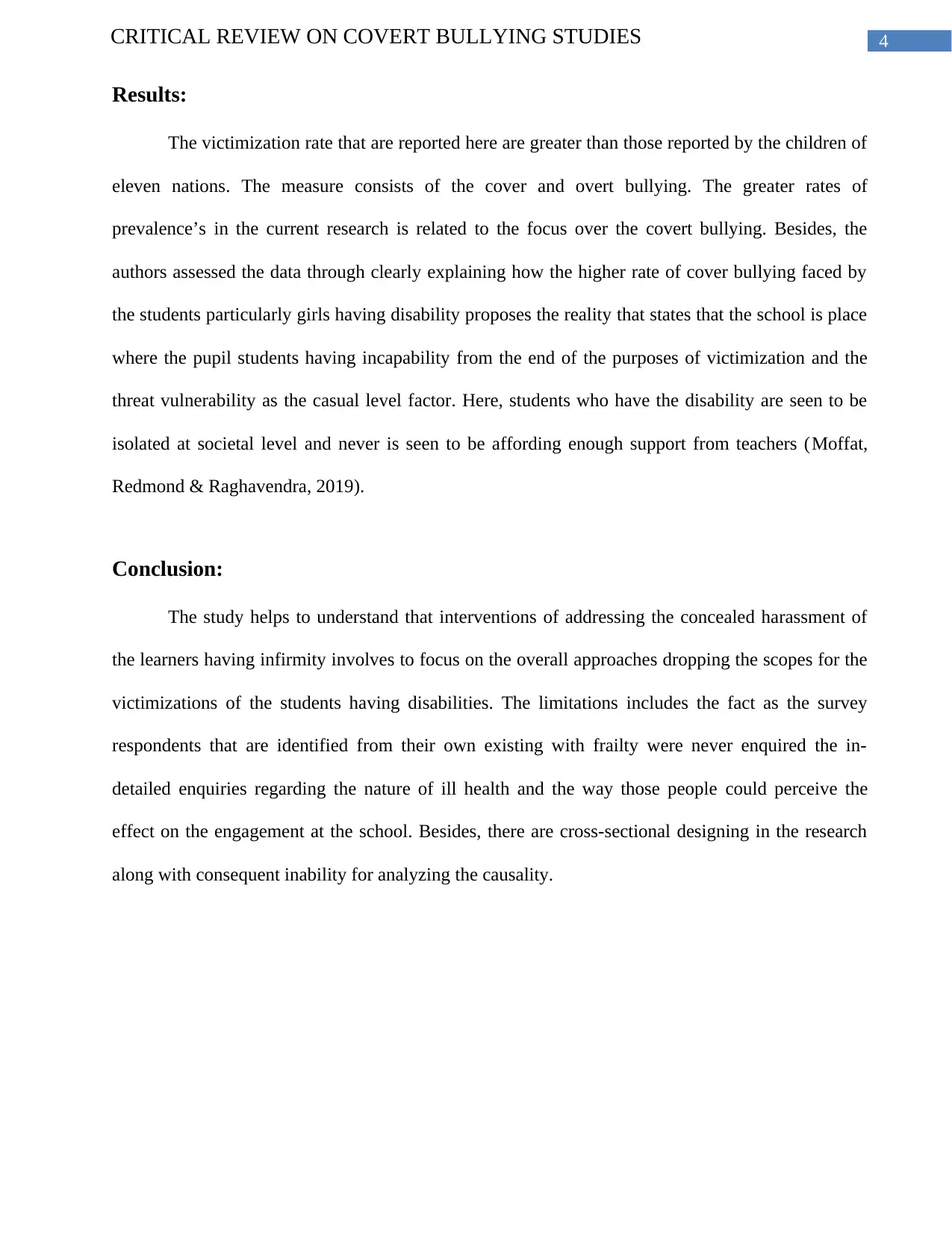
4CRITICAL REVIEW ON COVERT BULLYING STUDIES
Results:
The victimization rate that are reported here are greater than those reported by the children of
eleven nations. The measure consists of the cover and overt bullying. The greater rates of
prevalence’s in the current research is related to the focus over the covert bullying. Besides, the
authors assessed the data through clearly explaining how the higher rate of cover bullying faced by
the students particularly girls having disability proposes the reality that states that the school is place
where the pupil students having incapability from the end of the purposes of victimization and the
threat vulnerability as the casual level factor. Here, students who have the disability are seen to be
isolated at societal level and never is seen to be affording enough support from teachers (Moffat,
Redmond & Raghavendra, 2019).
Conclusion:
The study helps to understand that interventions of addressing the concealed harassment of
the learners having infirmity involves to focus on the overall approaches dropping the scopes for the
victimizations of the students having disabilities. The limitations includes the fact as the survey
respondents that are identified from their own existing with frailty were never enquired the in-
detailed enquiries regarding the nature of ill health and the way those people could perceive the
effect on the engagement at the school. Besides, there are cross-sectional designing in the research
along with consequent inability for analyzing the causality.
Results:
The victimization rate that are reported here are greater than those reported by the children of
eleven nations. The measure consists of the cover and overt bullying. The greater rates of
prevalence’s in the current research is related to the focus over the covert bullying. Besides, the
authors assessed the data through clearly explaining how the higher rate of cover bullying faced by
the students particularly girls having disability proposes the reality that states that the school is place
where the pupil students having incapability from the end of the purposes of victimization and the
threat vulnerability as the casual level factor. Here, students who have the disability are seen to be
isolated at societal level and never is seen to be affording enough support from teachers (Moffat,
Redmond & Raghavendra, 2019).
Conclusion:
The study helps to understand that interventions of addressing the concealed harassment of
the learners having infirmity involves to focus on the overall approaches dropping the scopes for the
victimizations of the students having disabilities. The limitations includes the fact as the survey
respondents that are identified from their own existing with frailty were never enquired the in-
detailed enquiries regarding the nature of ill health and the way those people could perceive the
effect on the engagement at the school. Besides, there are cross-sectional designing in the research
along with consequent inability for analyzing the causality.
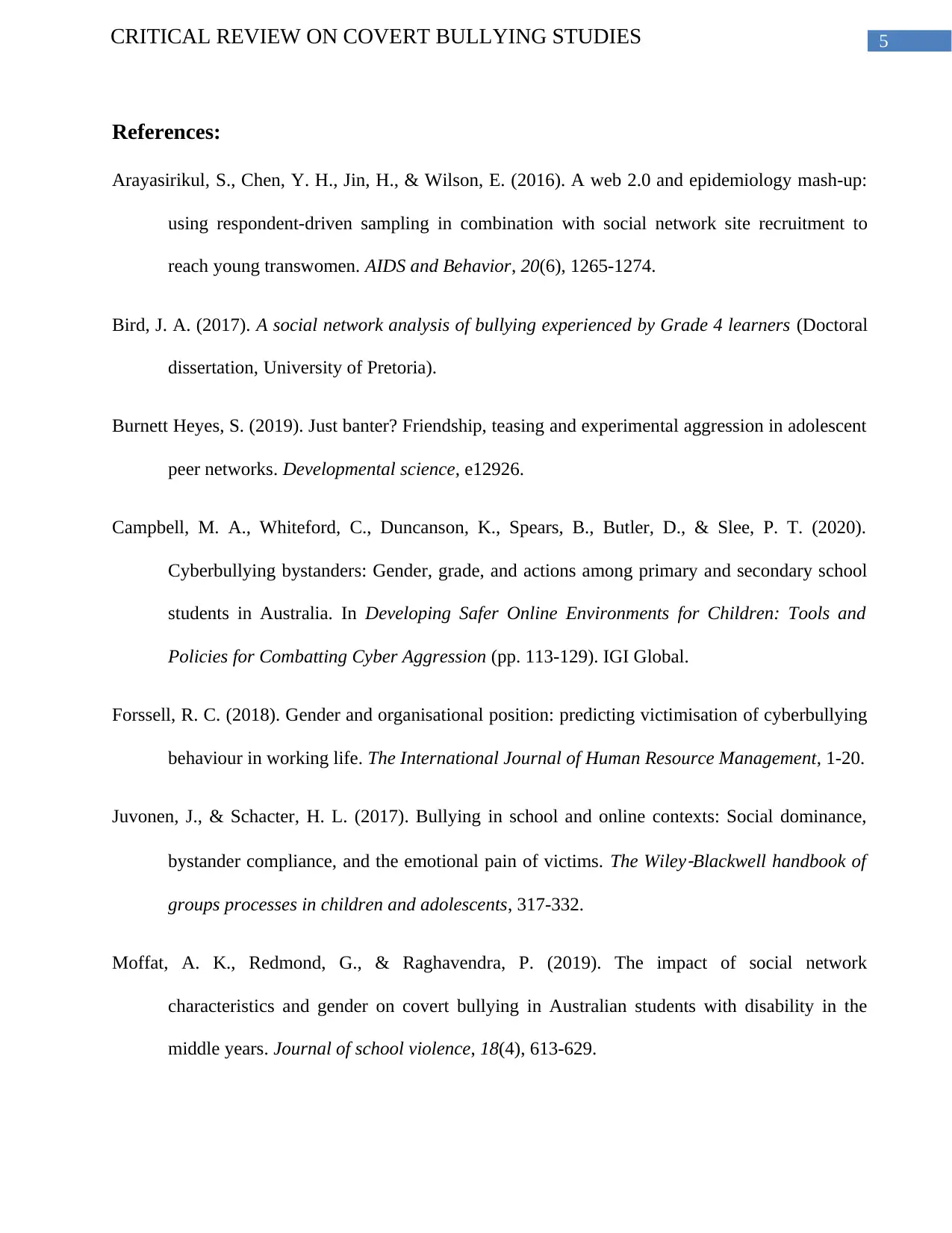
5CRITICAL REVIEW ON COVERT BULLYING STUDIES
References:
Arayasirikul, S., Chen, Y. H., Jin, H., & Wilson, E. (2016). A web 2.0 and epidemiology mash-up:
using respondent-driven sampling in combination with social network site recruitment to
reach young transwomen. AIDS and Behavior, 20(6), 1265-1274.
Bird, J. A. (2017). A social network analysis of bullying experienced by Grade 4 learners (Doctoral
dissertation, University of Pretoria).
Burnett Heyes, S. (2019). Just banter? Friendship, teasing and experimental aggression in adolescent
peer networks. Developmental science, e12926.
Campbell, M. A., Whiteford, C., Duncanson, K., Spears, B., Butler, D., & Slee, P. T. (2020).
Cyberbullying bystanders: Gender, grade, and actions among primary and secondary school
students in Australia. In Developing Safer Online Environments for Children: Tools and
Policies for Combatting Cyber Aggression (pp. 113-129). IGI Global.
Forssell, R. C. (2018). Gender and organisational position: predicting victimisation of cyberbullying
behaviour in working life. The International Journal of Human Resource Management, 1-20.
Juvonen, J., & Schacter, H. L. (2017). Bullying in school and online contexts: Social dominance,
bystander compliance, and the emotional pain of victims. The Wiley
‐Blackwell handbook of
groups processes in children and adolescents, 317-332.
Moffat, A. K., Redmond, G., & Raghavendra, P. (2019). The impact of social network
characteristics and gender on covert bullying in Australian students with disability in the
middle years. Journal of school violence, 18(4), 613-629.
References:
Arayasirikul, S., Chen, Y. H., Jin, H., & Wilson, E. (2016). A web 2.0 and epidemiology mash-up:
using respondent-driven sampling in combination with social network site recruitment to
reach young transwomen. AIDS and Behavior, 20(6), 1265-1274.
Bird, J. A. (2017). A social network analysis of bullying experienced by Grade 4 learners (Doctoral
dissertation, University of Pretoria).
Burnett Heyes, S. (2019). Just banter? Friendship, teasing and experimental aggression in adolescent
peer networks. Developmental science, e12926.
Campbell, M. A., Whiteford, C., Duncanson, K., Spears, B., Butler, D., & Slee, P. T. (2020).
Cyberbullying bystanders: Gender, grade, and actions among primary and secondary school
students in Australia. In Developing Safer Online Environments for Children: Tools and
Policies for Combatting Cyber Aggression (pp. 113-129). IGI Global.
Forssell, R. C. (2018). Gender and organisational position: predicting victimisation of cyberbullying
behaviour in working life. The International Journal of Human Resource Management, 1-20.
Juvonen, J., & Schacter, H. L. (2017). Bullying in school and online contexts: Social dominance,
bystander compliance, and the emotional pain of victims. The Wiley
‐Blackwell handbook of
groups processes in children and adolescents, 317-332.
Moffat, A. K., Redmond, G., & Raghavendra, P. (2019). The impact of social network
characteristics and gender on covert bullying in Australian students with disability in the
middle years. Journal of school violence, 18(4), 613-629.
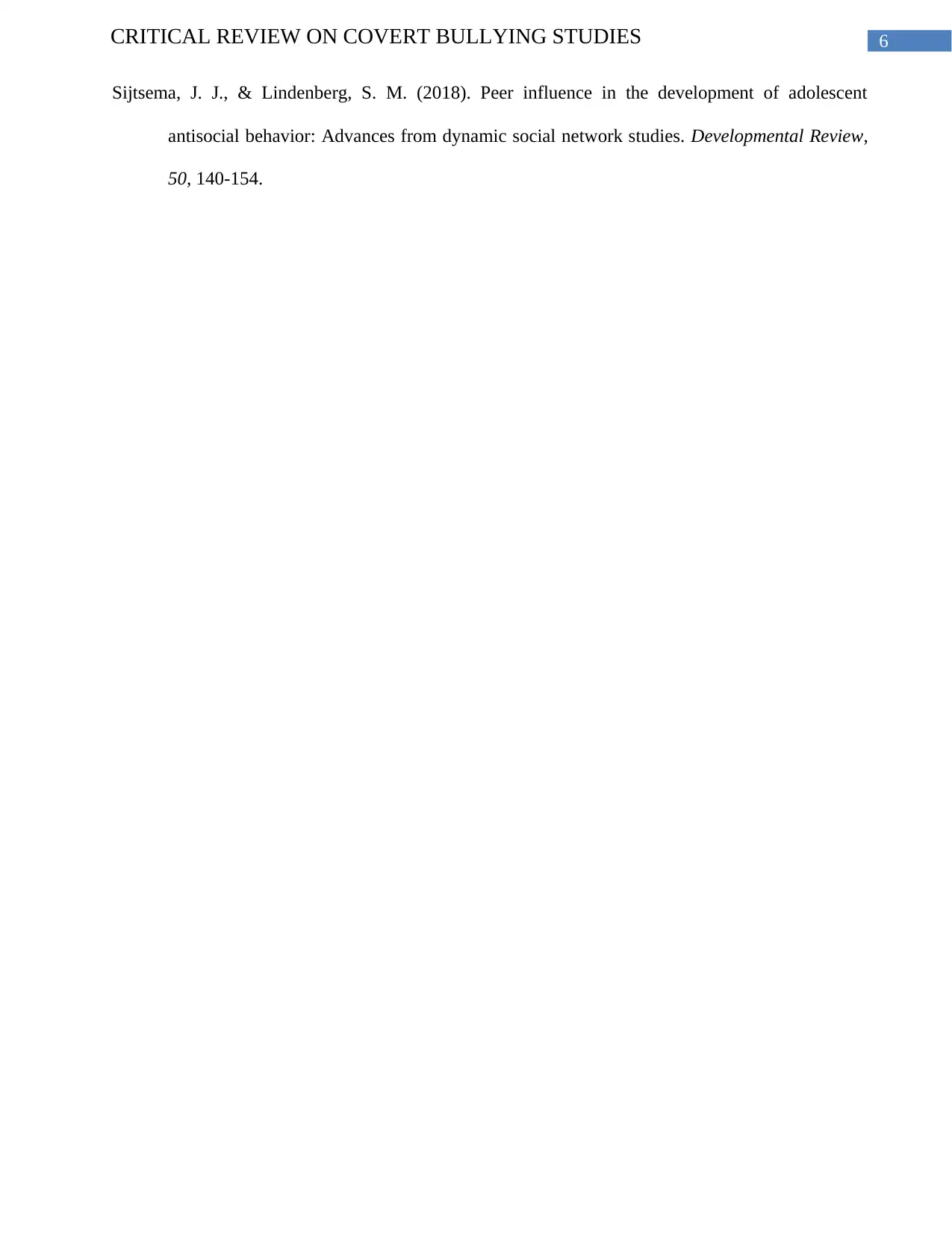
6CRITICAL REVIEW ON COVERT BULLYING STUDIES
Sijtsema, J. J., & Lindenberg, S. M. (2018). Peer influence in the development of adolescent
antisocial behavior: Advances from dynamic social network studies. Developmental Review,
50, 140-154.
Sijtsema, J. J., & Lindenberg, S. M. (2018). Peer influence in the development of adolescent
antisocial behavior: Advances from dynamic social network studies. Developmental Review,
50, 140-154.
1 out of 7
Your All-in-One AI-Powered Toolkit for Academic Success.
+13062052269
info@desklib.com
Available 24*7 on WhatsApp / Email
![[object Object]](/_next/static/media/star-bottom.7253800d.svg)
Unlock your academic potential
© 2024 | Zucol Services PVT LTD | All rights reserved.


